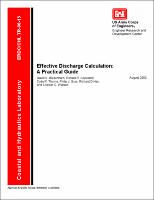Please use this identifier to cite or link to this item:
https://hdl.handle.net/11681/7464| Title: | Effective discharge calculation: a practical guide |
| Authors: | University of Nottingham University of East Anglia Colorado State University. Civil Engineering Department Biedenharn, David S. Copeland, Ronald R. Thorne, C. R. (Colin R.) Soar, Philip J. Hey, R. D. (Richard David) Watson, Chester C. |
| Keywords: | Bankfull discharge Channel-forming discharge Effective discharge Hydraulic geometry River engineering River management River restoration Stable channel design |
| Publisher: | Coastal and Hydraulics Laboratory (U.S.) Engineer Research and Development Center (U.S.) |
| Series/Report no.: | ERDC/CHL TR ; 00-15. |
| Description: | Technical report This report presents a procedure for calculating the effective discharge for alluvial rivers. An alluvial river adjusts the shape of its channel to the wide range of flows that mobilize the boundary sediments. However, in many rivers it has been shown that a single representative discharge can be used to determine a stable channel geometry. One method to determine this “channel-forming” discharge is based on the hypothesis that the discharge that transports the most sediment, over time, is the discharge that forms the channel. This is termed the effective discharge. Two other methods commonly used are the bankfull discharge and a discharge with a specific recurrence interval. While it may, under some circumstances, be possible to estimate the channel-forming discharge from the bankfull discharge, in practice, identification of bankfull stage in the field is often problematic. Even if bankfull stage can be identified, channel roughness and slope typically must be assumed to determine the bankfull discharge. Another method for determining channel-forming discharge is to assume a specific frequency from the annual flood peak frequency curve. However, there does not seem to be a recurrence interval that is generally applicable to alluvial rivers. The procedure for effective discharge calculation presented in this report is designed to have general applicability, have the capability to be applied consistently and to integrate the effects of physical processes responsible for determining channel dimensions. An example of the calculations necessary and applications of the effective discharge concept are presented. |
| Rights: | Approved for public release; distribution is unlimited. |
| URI: | http://hdl.handle.net/11681/7464 |
| Appears in Collections: | Technical Report |
Files in This Item:
| File | Description | Size | Format | |
|---|---|---|---|---|
| CHL-TR-00-15.pdf | 1.49 MB | Adobe PDF |  View/Open |